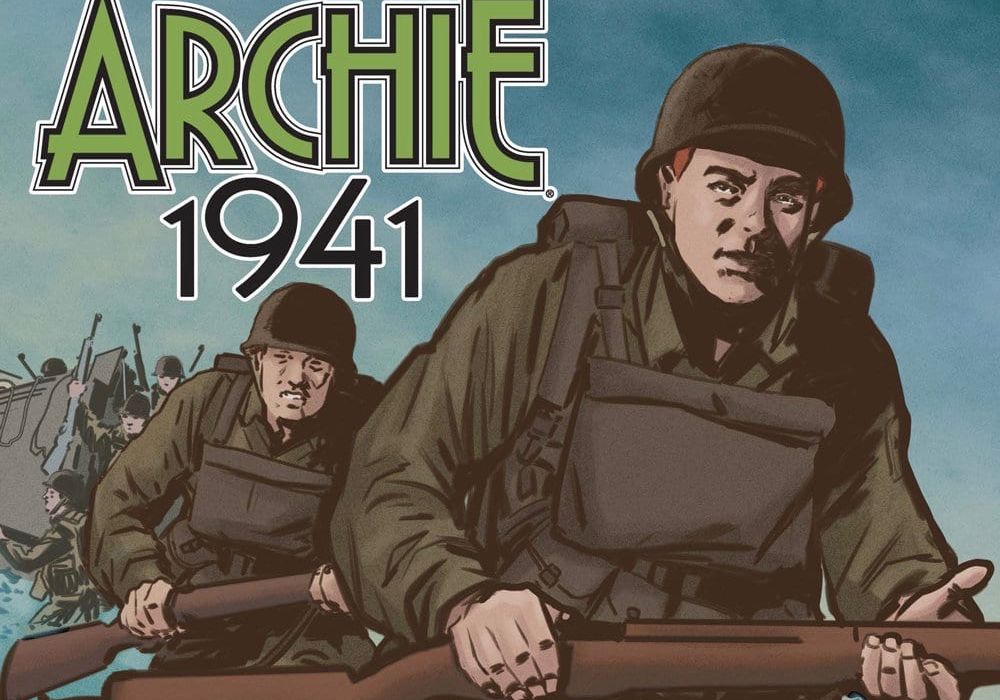On the whole, Archie Comics are known for interesting and innovative line extensions and their fearless ability to reimagine their core characters. Unfortunately, “Archie 1941” has done little, if anything, to distinguish itself and break new ground. Issue #4 is just more of the same. (Warning: contains minor spoilers.)
Written by Mark Waid and Brian AugustynCover by Peter Krause
and Rosario ‘Tito’ Peña
Illustrated by Peter Krause
Colored by Kelly Fitzpatrick
Lettered by Jack MorelliArchie is headed into action while the world watches and waits. Meanwhile, times are tough at home in Riverdale, while shortages are leading to impending rations, tensions are mounting. However, despite an uncertain future, unexpected relationships begin to form.
I really like the Archieverse. I certainly don’t like every issue of every series or even read them all but that’s a big part of the fun. There are more avenues to explore, more spinoffs and reboots and teamups than I could ever possibly read. Similarly, as a publisher, Archie Comics continues to keep things fresh and take creative chances by dreaming up new series, new worlds, and entirely new iterations of its classic characters, with new and different creative teams. From werewolves to biker gangs, vampires to budding pop stars and campy crossovers with iconic DC Comics characters, there’s something for everyone.
Naturally, a throwback Archie series that takes place in 1941 (the very year Archie Andrews debuted, no less) set against the inherently dramatic backdrop of WWII, would seem to set the stage for yet another hit. Put the powerhouse writing team of Mark Waid and Brian Augustyn at the helm and it’s an absolute no-brainer. Automatic pull list. Four issues into this five issue miniseries, however, the book continues to disappoint.
Visually, Peter Krause’s inks and Kelly Fitzpatrick’s colors continue to be top notch. Krause’s lines, in particular, walk the delicate balance of looking and feeling authentically retro without ever descending into schmaltziness or hollow sentimentality. There’s also a lot of detail, especially in terms of settings, without overwhelming the reader or creating unnecessary clutter. Often, once the setting is well established, the backgrounds fade away, allowing us to focus fully on the characters and their emotions. Not coincidentally, Fitzpatrick employs simple color fields in these panels, helping the characters pop off the page.
Elsewhere, Fitzpatrick uses a de-saturated color palette that reinforces the throwback look. There’s a wide variety of colors, especially rooted within the primaries of red, yellow and blue, but everything feels slightly faded, like you just discovered in the attic or basement cellar. If pages can look slightly musty, Fitzpatrick and Krause have done exactly that, to wondrous effect. Unfortunately, Waid and Augustyn’s script doesn’t nearly keep pace or rise to this level.
About halfway through the issue, Jughead says of Archie, “[H]e’s not just my best friend. Arch is the heart of this town. Look at how lost Riverdale is since he went away.” Without a doubt, in any Archie-centric book, he is clearly the focus. In the best moments, his emotions and experiences, his observations and musings capture the collective zeitgeist of Riverdale as a whole. Archie becomes the proxy and quintessential hero for a wide range of emotions and complex life experiences.
In the worst moments, Archie sucks the life out of Riverdale and selfishly monopolizes the attentions and emotions of his peers. He broods, he isolates, he whines. And everyone else just follows along. Any motivations they have – any goals, any hopes, any dreams – are quickly subsumed in deference to the objectives of Riverdale’s golden boy. Consequently, the otherwise well rounded cast of secondary and tertiary characters are reduced to nothing more than simple cardboard cutouts. Their only role, it seems, is to focus on Archie and cater to his whims.
Betty and Veronica bond because they both feel lonely. Pop and Jughead bond because they both miss Archie’s jovial, soothing presence. Archie’s parents feel guilty about letting their son enlist in the army in the first place and worry constantly about his safety, fixating instead of the price of gas and the lack of coffee.
The dialogue is basically fine and the structure adequate. There’s nothing wrong with the pacing or flow of the individual scenes. In the end, however, none of it really feels vital. Unlike other Archie Comics series that show us different facets of Archie and the rest of Riverdale’s denizens, there’s not really anything new here. No clever insights or interesting takes. Just a different setting and different time period in which Archie pines for Betty and Betty pines in return, like some sort of obscure AMC movie retread in which the produced licensed the Archie name without really understanding who the characters are and what makes them tick.
Final Verdict: 6.1 – Despite top-notch inks and colors that continue to deliver a wonderfully authentic retro aesthetic, “Archie 1941” #4 feels uninspired, slowly trudging toward the finish line of this 5-issue miniseries.




